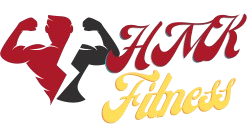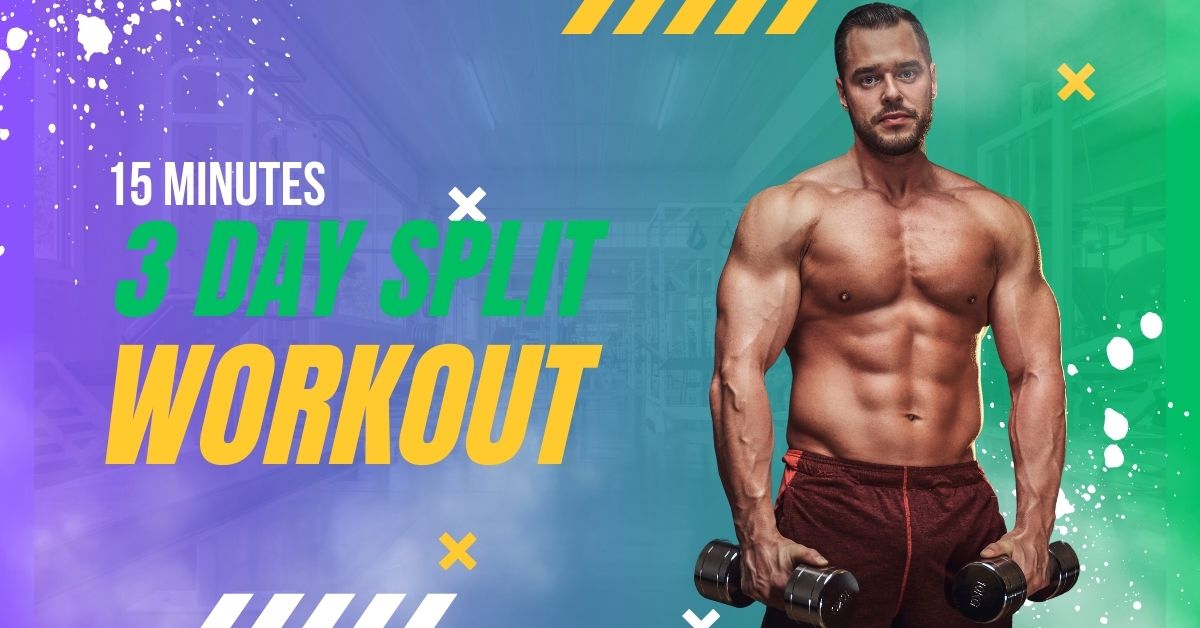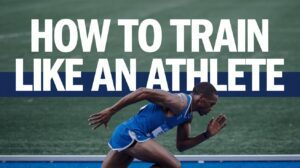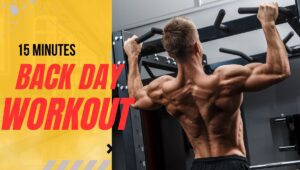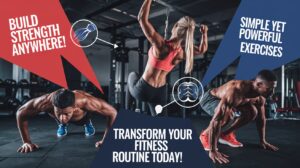A 3-day workout split is an efficient and versatile way to structure your gym routine, especially for those with a busy schedule. This method allows you to target all major muscle groups while providing enough recovery time, making it a popular choice for beginners and seasoned lifters. In this comprehensive guide, we’ll dive into the science, design, and execution of an effective three-day workout split tailored to help you achieve your fitness goals.
Table of Contents
Toggle1. Introduction to 3 Day Workout Split:
Definition and Overview of a 3 Day Workout Split:
A three-day workout split involves dividing your weekly training into three distinct sessions, each focusing on different muscle groups or movement patterns. This approach offers a balanced blend of intensity and recovery, allowing you to train hard while still giving your body ample time to recuperate. Whether you’re aiming to build muscle, lose fat, or simply maintain your current fitness level, a three-day split can be an excellent choice.
Benefits of a 3 Day Workout Split:
The 3 day workout split offers several advantages:
- Time Efficiency: Ideal for those with busy schedules, as it requires fewer gym visits.
- Balanced Training: Ensures all major muscle groups are targeted effectively.
- Optimal Recovery: Provides adequate rest between sessions, which is crucial for muscle growth and repair.
- Flexibility: Easily adaptable to different fitness levels and goals.
Who Should Use a 3 Day Workout Split
This type of workout split is suitable for a wide range of individuals:
- Beginners: Those new to weight training can benefit from the simplicity and focus of a 3 day split.
- Intermediate Lifters: Individuals who have established a workout routine and want to maintain or improve their results.
- Busy Professionals: People with limited time to spend in the gym who still want an effective and comprehensive workout routine.
2. The Science Behind Workout Splits:
Understanding Muscle Recovery:
Muscle recovery is a critical component of any successful training program. During strength training, muscles experience micro-tears, which then repair and grow stronger during rest periods. A 3-day workout split allows for these recovery periods, preventing overtraining and reducing the risk of injury.
Balancing Volume and Intensity:
Volume refers to the total work performed, while intensity refers to the effort required. In a 3 day workout split, it’s essential to balance these two elements. High-intensity workouts with lower volume can stimulate muscle growth, while moderate intensity with higher volume can improve endurance and muscle conditioning.
The Role of Rest in Muscle Growth:
Rest days are just as important as workout days. They allow the body to repair and grow stronger, making the most of the work done during training sessions. A 3 day split naturally incorporates rest periods, aligning with the body’s need for recovery.
3. Designing a 3 Day Workout Split:
Choosing Your Goals: Strength, Hypertrophy, or Endurance
Before you design your 3 day workout split, it’s crucial to define your primary goal:
- Strength: Focus on lower reps (4-6) with heavier weights to build maximal strength.
- Hypertrophy: Aim for moderate reps (8-12) with moderate weights to increase muscle size.
- Endurance: Higher reps (15-20) with lighter weights can improve muscular endurance.
Key Muscle Groups to Focus On
A well-rounded 3 day workout split should target all major muscle groups:
- Push Muscles: Chest, shoulders, triceps.
- Pull Muscles: Back, biceps.
- Leg Muscles: Quads, hamstrings, calves.
How to Structure Your Week
When structuring your week, consider the following sample routine:
- Day 1: Push (Chest, Shoulders, Triceps)
- Day 2: Pull (Back, Biceps)
- Day 3: Legs (Quads, Hamstrings, Calves)
- Rest Days: Between workout days or after the three-day cycle.
4. Common 3 Day Workout Split Routines:
Push/Pull/Legs Split
This is one of the most popular splits because it simplifies the workout process by grouping muscles based on their function.
- Day 1: Push – Focuses on chest, shoulders, and triceps.
- Day 2: Pull – Targets the back and biceps.
- Day 3: Legs – Emphasizes the lower body, including quads, hamstrings, and calves.
Full Body Split
In a full-body split, each workout targets all major muscle groups. This routine is beneficial for overall fitness and muscle conditioning.
- Day 1: Full Body Routine – Squats, deadlifts, and bench press exercises.
- Day 2: Full Body Routine – Similar structure but with different exercises.
- Day 3: Full Body Routine – Another variation with adjustments in intensity.
Upper/Lower/Full Body Split
This split offers a mix of focusing on the upper and lower body separately, followed by a comprehensive full-body workout.
- Day 1: Upper Body Workout – Focus on the chest, back, shoulders, and arms.
- Day 2: Lower Body Workout – Target quads, hamstrings, glutes, and calves.
- Day 3: Full Body Workout – A balanced routine engaging the entire body.
5. Push/Pull/Legs 3 Day Workout Split:
Day 1: Push (Chest, Shoulders, Triceps)
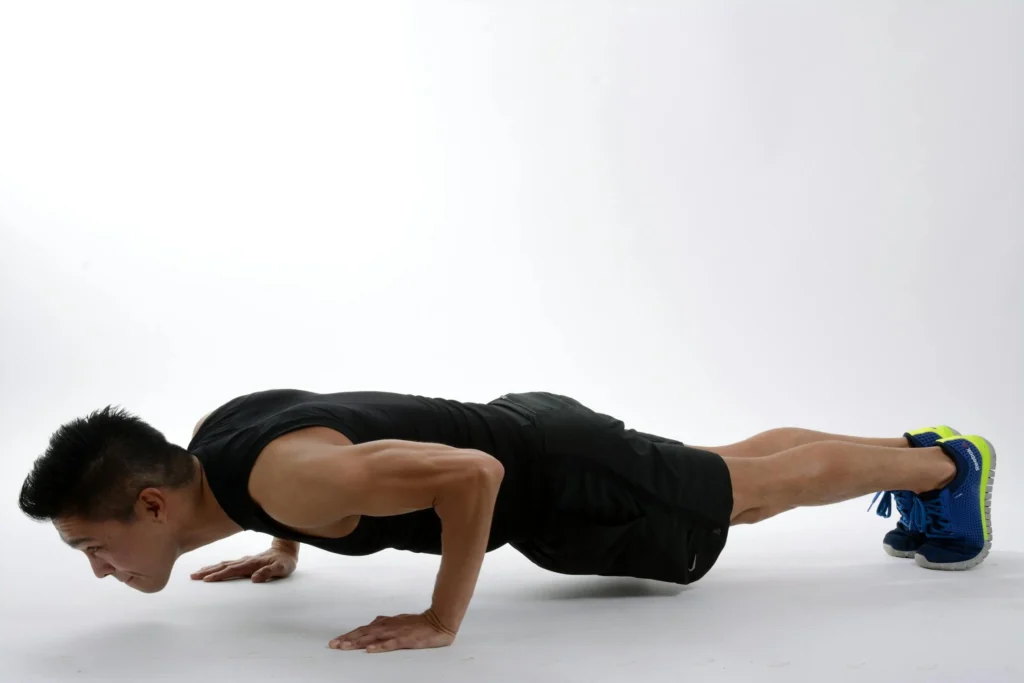
The push workout focuses on pressing movements that target the upper body.
- Chest: Bench Press, Incline Dumbbell Press, Chest Flyes.
- Shoulders: Overhead Press, Lateral Raises, Front Raises.
- Triceps: Tricep Dips, Tricep Pushdowns, Overhead Tricep Extension.
Day 2: Pull (Back, Biceps)
Continuing with the pull workout, the focus here is on exercises that engage the back and biceps, helping to build a strong and balanced upper body.
- Back:
- Pull-Ups: A compound exercise that targets the lats, biceps, and shoulders. Variations like wide-grip or close-grip pull-ups can be used to emphasize different areas.
- Bent-over rows work the upper and middle back, along with the rear deltoids. You can perform this with a barbell or dumbbell.
- Lat Pulldowns: An excellent machine-based alternative to pull-ups, focusing on the lats.
- Single-Arm Dumbbell Rows: Target the lats and rhomboids, improving muscle imbalances.
- Biceps:
- Barbell Curls: A fundamental bicep exercise that targets the overall bicep muscle.
- Hammer Curls: Focuses on the brachialis, the muscle underneath the biceps, which contributes to arm thickness.
- Concentration Curls: Isolates the biceps for focused contraction and growth.
Day 3: Legs (Quads, Hamstrings, Calves)
The leg day focuses on the lower body, ensuring balanced development and strength.
- Quads:
- Squats: The king of all leg exercises, targeting the quads, hamstrings, and glutes. Variations like front squats can place more emphasis on the quads.
- Leg Press: A machine-based exercise that allows heavy lifting while focusing on the quads.
- Lunges: Engages the quads, hamstrings, and glutes while improving balance and stability.
- Hamstrings:
- Romanian Deadlifts: Focuses on the hamstrings and glutes, with the added benefit of strengthening the lower back.
- Leg Curls: A machine-based exercise that isolates the hamstrings.
- Calves:
- Standing Calf Raises: Primarily targets the gastrocnemius muscle in the calves.
- Seated Calf Raises: Focuses more on the soleus muscle, which lies underneath the gastrocnemius.
6. Full Body 3 Day Workout Split:
The full body split is an excellent option for those who want to engage all major muscle groups in every workout. This routine is efficient and ensures that each muscle group gets worked multiple times a week, promoting balanced development.
Day 1: Full Body Routine
The first day focuses on compound movements that engage multiple muscle groups:
- Squats: Targets the legs and core.
- Bench Press: Focuses on the chest, shoulders, and triceps.
- Bent-Over Rows: Engages the back and biceps.
- Overhead Press: Works the shoulders and triceps.
- Deadlifts: Targets the entire posterior chain, including the lower back, glutes, and hamstrings.
Day 2: Full Body Routine (Alternate Exercises)
On the second day, alternate exercises to provide variety and target the muscles from different angles:
- Leg Press: A lower body compound movement focusing on the quads.
- Incline Dumbbell Press: Targets the upper chest and shoulders.
- Lat Pulldowns: Engages the back and biceps.
- Dumbbell Shoulder Press: Focuses on the shoulders with a slightly different range of motion than the barbell.
- Romanian Deadlifts: Focuses on the hamstrings and glutes.
Day 3: Full Body Routine (Different Intensities)
The third day involves varying the intensity to prevent overtraining and to target muscle fibers differently:
- Lunges: Engage the entire lower body.
- Push-Ups: A bodyweight exercise focusing on the chest, shoulders, and triceps.
- Cable Rows: Engages the back and biceps with a different resistance curve.
- Lateral Raises: Isolates the shoulders for focused development.
- Plank: Engages the core, helping to build stability and strength.
7. Upper/Lower/Full Body Split:
This split combines focused upper and lower body days with a comprehensive full-body workout, offering a balanced approach to muscle development.
Day 1: Upper Body Workout
The upper body day focuses on the chest, back, shoulders, and arms:
- Chest: Bench Press, Incline Dumbbell Press.
- Back: Pull-Ups, Bent-Over Rows.
- Shoulders: Overhead Press, Lateral Raises.
- Arms: Barbell Curls, Tricep Dips.
Day 2: Lower Body Workout
The lower body day is all about strengthening the legs and core:
- Quads: Squats, Leg Press.
- Hamstrings: Romanian Deadlifts, Leg Curls.
- Glutes: Glute Bridges, Lunges.
- Calves: Standing Calf Raises, Seated Calf Raises.
Day 3: Full Body Workout
The full-body workout combines elements from both the upper and lower body routines:
- Squats: For lower body strength.
- Deadlifts: Engages the entire posterior chain.
- Bench Press: Focuses on the chest, shoulders, and triceps.
- Pull-Ups: Engages the back and biceps.
- Plank: Strengthens the core.
8. Tailoring the 3 Day Split to Your Fitness Level:
Modifications for Beginners
Beginners should focus on mastering form and building a solid foundation:
- Lower Weight, Higher Reps: Start with lighter weights and higher reps to build endurance and learn proper technique.
- Simplified Exercises: Focus on fundamental movements like squats, bench presses, and rows.
- Longer Rest Periods: Allow more rest between sets to ensure full recovery.
Intermediate Adjustments
For those who have a few months of consistent training, it’s time to increase the intensity:
- Increase Weight: Begin to lift heavier weights while maintaining proper form.
- Vary Rep Ranges: Incorporate a mix of strength (4-6 reps) and hypertrophy (8-12 reps) rep ranges.
- Shorter Rest Periods: Reduce rest times between sets to increase the intensity and improve conditioning.
Advanced Variations
Advanced lifters can further challenge themselves by introducing more complex elements:
- Advanced Techniques: Incorporate drop sets, supersets, and pause reps to intensify the workout.
- Focus on Weak Points: Identify and target lagging muscle groups with additional exercises or volume.
- Periodization: Plan your workouts in cycles to systematically vary intensity and volume, promoting continuous progress.
9. The Importance of Progressive Overload:
What is Progressive Overload?
Progressive overload is the gradual increase of stress placed on the body during exercise, which is essential for muscle growth and strength gains. It involves increasing the weight, reps, sets, or intensity over time to challenge the muscles continuously.
Methods to Implement Progressive Overload in a 3 Day Split
There are several ways to apply progressive overload in your routine:
- Increase Weight: Gradually add more weight to your lifts.
- Increase Reps or Sets: Add more repetitions or sets to your exercises.
- Improve Form and Range of Motion: To make the exercise more challenging, focus on perfecting your form and increasing your range of motion.
- Reduce Rest Time: Shorten the rest periods between sets to increase intensity.
Tracking Progress Over Time
To ensure you’re applying progressive overload effectively, it’s important to track your progress:
- Keep a Workout Log: Record each exercise’s weights, reps, and sets.
- Set Specific Goals: Establish clear, measurable goals, such as lifting a certain weight or completing a specific number of reps.
- Regularly Assess and Adjust: Review your progress and adjust your routine to continue challenging yourself.
10. Nutrition and Recovery for a 3 Day Workout Split:
Macronutrients and Their Role in Muscle Growth
Nutrition plays a crucial role in supporting your workout efforts:
- Protein: Essential for muscle repair and growth. Aim for 1.6-2.2 grams of protein per kilogram of body weight.
- Carbohydrates: Provide energy for your workouts and aid in recovery. Focus on complex carbs like oats, sweet potatoes, and whole grains.
- Fats: Support hormone production and overall health. Include healthy fats from sources like avocados, nuts, and olive oil.
Hydration and Its Impact on Performance:
Staying hydrated is key to maintaining performance and recovery:
- Water Intake: Aim for at least 3-4 liters of water daily, more if you’re sweating heavily during workouts.
- Electrolytes: Ensure you replenish electrolytes, especially during intense or prolonged exercise.
Recovery Strategies: Sleep, Stretching, and Supplements:
Recovery strategies are critical for optimizing your results:
- Sleep: Aim for 7-9 hours of quality sleep per night to support muscle recovery and overall health.
- Stretching: Incorporate dynamic stretching before workouts and static stretching afterward to improve flexibility and reduce muscle soreness.
Supplements: To support muscle growth and recovery, consider supplements like whey protein, creatine, and branched-chain amino acids (BCAAs).
- Whey Protein: A quick and convenient source of high-quality protein, helping you meet your daily protein needs.
- Creatine: Supports increased strength and muscle mass by enhancing your ability to perform high-intensity exercises.
- BCAAs: Help reduce muscle soreness and support muscle recovery, especially beneficial during intense training phases.
11. Combining Cardio with a 3 Day Workout Split:
Should You Add Cardio?
Cardio can be beneficial depending on your specific goals:
- For Fat Loss: Incorporating cardio can help create a calorie deficit, which is essential for fat loss.
- For Cardiovascular Health: Cardio is important for heart health, improving endurance, and overall fitness.
- For Muscle Maintenance: Light to moderate cardio can aid recovery without compromising muscle gains.
How to Incorporate Cardio without Hindering Muscle Gains
If your primary goal is muscle gain, it’s important to plan your cardio sessions carefully:
- Timing: Perform cardio on non-lifting days or after weight training to avoid interfering with your strength workouts.
- Intensity: Choose moderate-intensity steady-state cardio (like walking or cycling) or short bouts of high-intensity interval training (HIIT) that will not compromise your recovery.
- Duration: Limit cardio sessions to 20-30 minutes if your focus is on muscle gain, to prevent excessive calorie burning that could hinder muscle growth.
Best Types of Cardio for Muscle Maintenance:
Certain types of cardio are better suited to preserving muscle mass while promoting fat loss and cardiovascular health:
- Walking or Incline Walking: A low-impact option that burns calories without taxing your muscles too much.
- Cycling: Offers a full-body workout and can be easily adjusted in intensity.
- Rowing: Engages multiple muscle groups and provides both cardio and strength benefits.
12. Common Mistakes to Avoid:
Overtraining and Its Dangers:
Overtraining occurs when you push your body beyond its ability to recover, leading to burnout, decreased performance, and an increased risk of injury. Signs of overtraining include persistent fatigue, irritability, insomnia, and prolonged muscle soreness. It’s crucial to listen to your body and incorporate adequate rest days, especially with a 3 day workout split that involves intense training.
Neglecting Recovery Days:
Recovery days are not just for resting; they are when your muscles repair and strengthen. Skipping rest days or filling them with too much additional exercise can hinder progress. Make sure to use these days for light activities like walking or stretching to promote recovery without overloading your system.
Poor Form and Its Consequences:
Using incorrect form during exercises can lead to injuries and ineffective workouts. Poor form often results from lifting too heavy, trying to rush through reps, or not paying attention to technique. To avoid this:
- Focus on Technique: Master the proper form before increasing weight.
- Use a Mirror: Check your form in a mirror or record yourself to ensure you’re performing exercises correctly.
- Ask for Help: Don’t hesitate to ask a trainer or experienced lifter for advice on proper technique.
13. Adapting the 3 Day Workout Split for Different Goals:
Fat Loss:
If fat loss is your primary goal, the 3 day workout split can be adapted by:
- Increasing Cardio: Add 2-3 weekly cardio sessions to burn extra calories.
- Caloric Deficit: Combine your workout routine with a well-structured diet that places you in a caloric deficit.
- Circuit Training: Incorporate circuit training into your split to increase calorie burn and metabolic rate.
Muscle Gain:
For those focused on muscle gain, emphasize:
- Progressive Overload: Continuously challenge your muscles by increasing weights or volume.
- High Protein Intake: Ensure you consume sufficient protein to support muscle growth.
- Longer Rest Between Sets: Allow 2-3 minutes between sets to fully recover and lift heavier weights.
Maintenance and General Fitness:
If you’re looking to maintain your current physique or improve general fitness:
- Balanced Diet: Maintain a balanced diet that meets your energy needs without excessive calorie surplus or deficit.
- Moderate Intensity: Focus on moderate weights and reps to engage muscles without overtraining.
- Consistency: Stick to a consistent workout routine and incorporate variety to keep workouts enjoyable and effective.
14. Conclusion:
A 3 day workout split offers a flexible and efficient approach to achieving various fitness goals, whether building muscle, losing fat, or maintaining overall fitness. By balancing intensity with recovery and tailoring the split to your specific needs, you can maximize your workout results while enjoying the benefits of a well-structured routine. Remember to stay consistent, prioritize recovery, and adjust your workouts to continue progressing on your fitness journey.
15. FAQs about 3 Day Workout Splits:
How long should each workout last?
Each workout should typically last 45 minutes to 1 hour, depending on the intensity and volume. Ensure that you give each muscle group enough attention without rushing through exercises.
Can I do a 3 day split forever?
Yes, a 3 day split can be used long-term as it provides a good balance of intensity and recovery. However, it’s important to periodically reassess your routine and adjust based on your progress and changing goals.
What if I miss a workout?
If you miss a workout, you can either make it up on your next available day or continue your regular schedule. Missing an occasional workout won’t derail your progress as long as you’re consistent.
Is a 3 day workout split effective for weight loss?
Yes, when combined with a proper diet, a 3 day workout split can be very effective for weight loss. Adding cardio and maintaining a caloric deficit will enhance fat loss while preserving muscle mass.
Should I change my split every few months?
While changing your split frequently is unnecessary, varying your routine every 2-3 months can prevent plateaus and keep your workouts challenging and interesting.
How do I stay motivated on a 3 day split?
To stay motivated, set clear, achievable goals, track your progress, and regularly assess and celebrate your improvements. Incorporating a variety of exercises and challenging yourself with new techniques can also keep your workouts engaging.
